Data Visualization with ggplot2
Jennifer Thompson, MPH
2018-06-06
ggplot2: data visualization system based on the grammar of graphics
ggplot2: data visualization system based on the grammar of graphics
- Quickly make beautiful, high-quality visualizations
- Map plot characteristics directly to qualities of data
- Automatically create informative plot legends
- Show subsets of data using small multiples
Goals
We will understand how:
- Data are mapped to
aesthetics - Plots are built in layers by
geoms - Control aesthetics using
scales - Show small multiples using
facets - Control axes and legends using
scales/guides - Change plot appearance using
themesand other options - Save plots using
ggsave()
Plan
- General overview of key concepts:
aesthetics,geoms, layering,scales,facets,themes - Step-by-step example, to demonstrate details
Note: This is not an exhaustive tutorial; it is an overview of the features I use most often. Much more at ggplot2.tidyverse.org!
The Grammar of Graphics
- Largely developed by Leland Wilkinson in The Grammar of Graphics
- Extended by Hadley Wickham (paper), original author of
ggplot2
The Grammar of Graphics
- Largely developed by Leland Wilkinson in The Grammar of Graphics
- Extended by Hadley Wickham (paper), original author of
ggplot2
A little time learning the grammar ➡️
Power, ease in creating beautiful, informative graphics
The Grammar of Graphics
- Largely developed by Leland Wilkinson in The Grammar of Graphics
- Extended by Hadley Wickham (paper), original author of
ggplot2
A little time learning the grammar ➡️
Power, ease in creating beautiful, informative graphics
(compare this to trying to remember all the arguments to par)
Components of Statistical Graphics
- Data
- Aesthetic mappings of the data (eg, location or size)
- Geometric objects (ie, the shape of the data)
- Scales
- Statistical transformation
- Coordinates
Components of Statistical Graphics
- Data
- Aesthetic mappings of the data (eg, location or size)
- Geometric objects (ie, the shape of the data)
- Scales
- Statistical transformation
- Coordinates
ggplot( data = df, aes(x = xvar, y = yvar)) + geom_point(stat = "identity") + scale_x_continuous( limits = c(min(df$xvar), max(df$xvar)), name = "X Axis" ) + scale_y_continuous( limits = c(min(df$yvar), max(df$yvar)), name = "Y Axis" )
Base R
with(df, plot(yvar ~ xvar))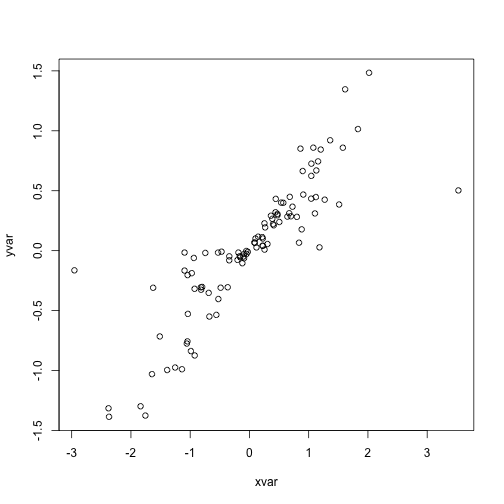
ggplot2
ggplot( data = df, aes(x = xvar, y = yvar)) + geom_point()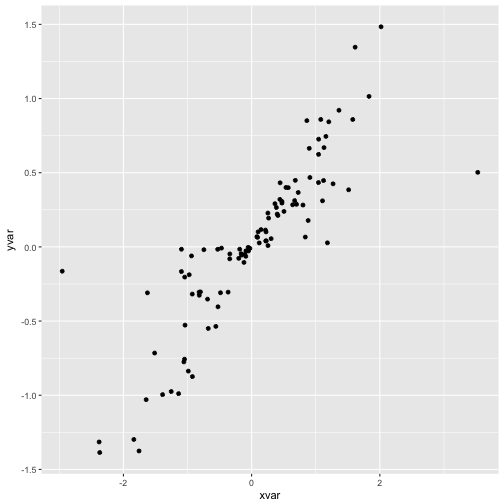
Base R
with(df, plot(yvar ~ xvar))
ggplot2
ggplot( data = df, aes(x = xvar, y = yvar)) + geom_point()
Notice: ggplot2 knows which stat, scales to use by default
It Always Starts with Data
ggplot(data = ..., ...)
Everything starts with a data.frame.
Anything that represents data on the plot must be within a data.frame.
Represent Data with aesthetics
- "Aesthetics" = how we map the values of data to the appearance of the plot
- Examples:
- X, Y axis values
- Color, shape, sizes of points
- Opacity, fill of shapes
print(head(df, n = 3), digits = 2)## xvar yvar## 1 -0.34 -0.08## 2 -1.64 -1.03## 3 -1.06 -0.78ggplot( data = df, aes(x = xvar, y = yvar))print(head(df, n = 3), digits = 2)## xvar yvar## 1 -0.34 -0.08## 2 -1.64 -1.03## 3 -1.06 -0.78ggplot( data = df, aes(x = xvar, y = yvar))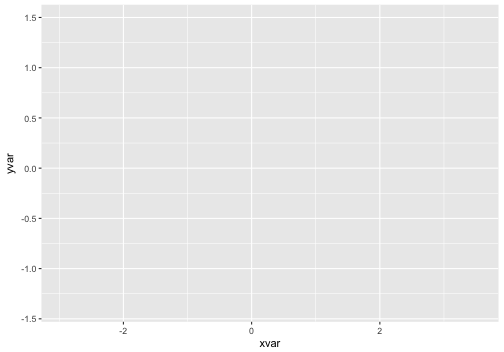
print(head(df, n = 3), digits = 2)## xvar yvar## 1 -0.34 -0.08## 2 -1.64 -1.03## 3 -1.06 -0.78ggplot( data = df, aes(x = xvar, y = yvar))
What Do You Notice?
- Correct X, Y limits
- Axis labels
- ...no actual data
print(head(df, n = 3), digits = 2)## xvar yvar## 1 -0.34 -0.08## 2 -1.64 -1.03## 3 -1.06 -0.78ggplot( data = df, aes(x = xvar, y = yvar))
What Do You Notice?
- Correct X, Y limits
- Axis labels
- ...no actual data
We haven't told it how to show the data!
aesthetics + geoms = 👯
Represent Data with geoms
geoms determine the shape of the data.
ggplot( data = df, aes(x = xvar, y = yvar)) + geom_point()Represent Data with geoms
geoms determine the shape of the data.
ggplot( data = df, aes(x = xvar, y = yvar)) + geom_point()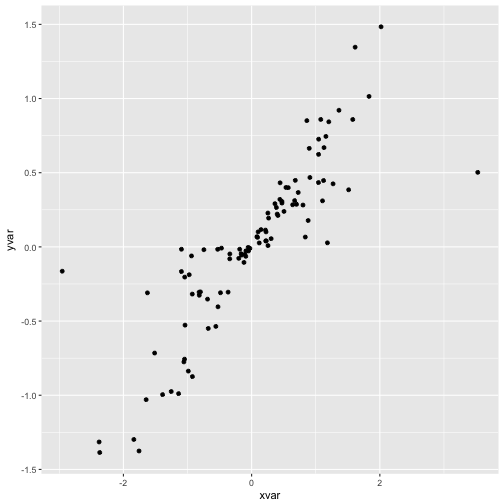
Represent Data with geoms
geoms determine the shape of the data.
ggplot( data = df, aes(x = xvar, y = yvar)) + geom_line()Represent Data with geoms
geoms determine the shape of the data.
ggplot( data = df, aes(x = xvar, y = yvar)) + geom_line()
Different geoms...
different aesthetics
The aesthetics you need depend on the geom you want to show.
Examples:
geom_point,geom_lineeach need only X, Y valuesgeom_ribbonneeds X, but rather than a single Y, it needsyminandymax
Different geoms...
different aesthetics
The aesthetics you need depend on the geom you want to show.
Examples:
geom_point,geom_lineeach need only X, Y valuesgeom_ribbonneeds X, but rather than a single Y, it needsyminandymax
Your Turn!
Look at the help files for these geoms and see what aesthetics each one needs.
library(ggplot2)?geom_line?geom_boxplot?geom_bar?geom_ribbonYour Turn!
Using the gapminder dataset from the year 2007, show the relationship between gdpPercap and lifeExp using aesthetics and geoms.
# install.packages("gapminder")library(gapminder)head(gapminder)## # A tibble: 6 x 6## country continent year lifeExp pop gdpPercap## <fct> <fct> <int> <dbl> <int> <dbl>## 1 Afghanistan Asia 1952 28.8 8425333 779## 2 Afghanistan Asia 1957 30.3 9240934 821## 3 Afghanistan Asia 1962 32.0 10267083 853## 4 Afghanistan Asia 1967 34.0 11537966 836## 5 Afghanistan Asia 1972 36.1 13079460 740## 6 Afghanistan Asia 1977 38.4 14880372 786gap2007 <- subset(gapminder, year == 2007)Your Turn!
p <- ggplot( data = gap2007, aes(x = gdpPercap, y = lifeExp))p + geom_point()
p + geom_line()
geoms + stats
Some geoms require the user to supply all the information needed to map each point.
geom_point,geom_line,geom_ribbon
geoms + stats
Some geoms require the user to supply all the information needed to map each point.
geom_point,geom_line,geom_ribbon
Others use stats behind the scenes to summarize the data.
ggplot( data = df, aes(x = 1, y = yvar)) + geom_boxplot()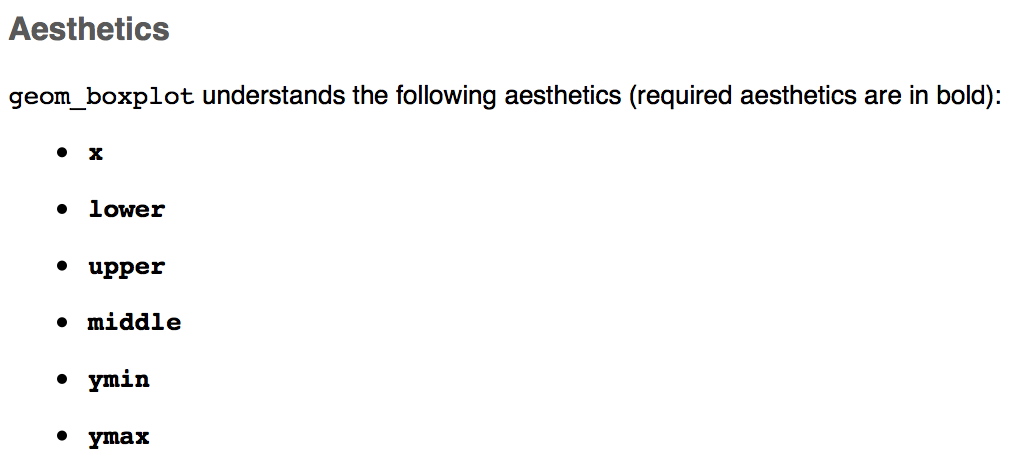

Often we won't need to call stats explicitly; geoms have excellent defaults that do much of the work for us!
Layers = Power 💪
Scenario: Raw Data + Regression Line
We want to represent the same data, using a summary as well as the raw data.
We can do this by layering geoms.
ggplot( data = gap2007, aes(x = gdpPercap, y = lifeExp)) + geom_point()
Scenario: Raw Data + Regression Line
We want to represent the same data, using a summary as well as the raw data.
We can do this by layering geoms.
ggplot( data = gap2007, aes(x = gdpPercap, y = lifeExp)) + geom_point() + geom_smooth()
Scenario: Raw Data + Regression Line
We want to represent the same data, using a summary as well as the raw data.
We can do this by layering geoms.
ggplot( data = gap2007, aes(x = gdpPercap, y = lifeExp)) + geom_point() + geom_smooth() + geom_rug()
Your Turn!
Summarize and show raw data for each country's gross domestic product (gdpPercap).
For extra credit 😁, do this separately for each continent.
- What
geomswould you use? - What
aestheticswould you use?
Your Turn!
Summarize and show raw data for each country's gross domestic product (gdpPercap).
For extra credit 😁, do this separately for each continent.
- What
geomswould you use? - What
aestheticswould you use?
ggplot( data = gap2007, aes(x = continent, y = gdpPercap)) + geom_boxplot() + geom_point()What would you change?

Positions
positions help us change the position of data a bit. Positions are still based on aesthetics, but sometimes it is helpful to modify those values.
For example, you may have many single points with the same value, or several groups contained within one value.
Positions
positions help us change the position of data a bit. Positions are still based on aesthetics, but sometimes it is helpful to modify those values.
For example, you may have many single points with the same value, or several groups contained within one value.
Common position functions:
position_dodge(): vertical position stays the same; horizontal changesposition_stack(): stacks bars on top of one anotherposition_fill(): stacks bars and standardizes each to the same heightposition_jitter(): adds random noise to values to avoid overplotting
Example: Barcharts
rct_df <- data.frame( trt = factor(c("A", "A", "B", "B")), sex = factor(rep(c("Male", "Female"), 2)), npts = c(52, 48, 65, 75))ggplot( data = rct_df, aes(x = trt, y = npts, group = sex, fill = sex)) + geom_bar( stat = "identity", position = position_dodge() )position_dodge()

Example: Barcharts
rct_df <- data.frame( trt = factor(c("A", "A", "B", "B")), sex = factor(rep(c("Male", "Female"), 2)), npts = c(52, 48, 65, 75))ggplot( data = rct_df, aes(x = trt, y = npts, group = sex, fill = sex)) + geom_bar( stat = "identity", position = position_stack() )position_stack()

Example: Barcharts
rct_df <- data.frame( trt = factor(c("A", "A", "B", "B")), sex = factor(rep(c("Male", "Female"), 2)), npts = c(52, 48, 65, 75))ggplot( data = rct_df, aes(x = trt, y = npts, group = sex, fill = sex)) + geom_bar( stat = "identity", position = position_fill() )position_fill()

Positions
Because positions are functions, we can add arguments to control them further.
ggplot( data = rct_df, aes(x = trt, y = npts, group = sex, fill = sex)) + geom_bar( stat = "identity", position = position_dodge2(padding = 0.2) )
Positions
But if we want the default position settings, we can use shortcuts:
ggplot( data = rct_df, aes(x = trt, y = npts, group = sex, fill = sex)) + geom_bar( stat = "identity", position = "dodge2" )
Your Turn!
Take the boxplot we made earlier and use a position to reduce the overplotting of the raw data.
ggplot( data = gap2007, aes(x = continent, y = gdpPercap)) + geom_boxplot() + geom_point()
Your Turn!
ggplot( data = gap2007, aes(x = continent, y = gdpPercap)) + geom_boxplot() + geom_point( position = "jitter" )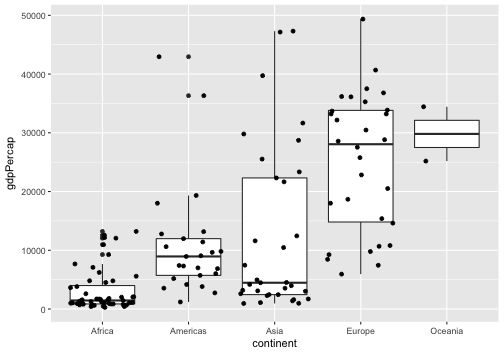
Your Turn!
ggplot( data = gap2007, aes(x = continent, y = gdpPercap)) + geom_boxplot() + geom_point( position = position_jitter(width = 0.25) )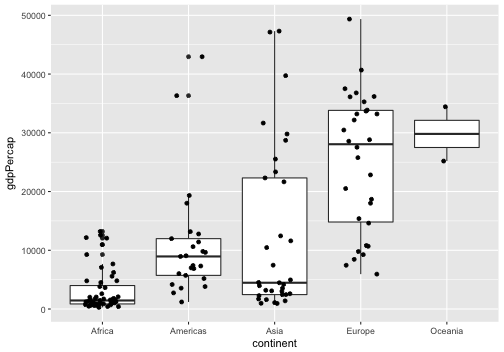
Inheritance
Did You Notice...
...so far, we have only explicitly specified our data and aesthetics in the initial ggplot() call?
Even when we had three separate layers!
Inheritance
Did You Notice...
...so far, we have only explicitly specified our data and aesthetics in the initial ggplot() call?
Even when we had three separate layers!
ggplot2 uses inheritance. This means that each layer uses the same data and aesthetics set in ggplot(...), unless we tell it otherwise.
- Simplicity: Inheritance means we don't have to specify data and aesthetics multiple times
- Power: We can use different datasets or aesthetics for each layer if we want to
Example of Inheritance: Marginal Effects Plots
We may show the point estimate and confidence interval for a continuous variable from a linear regression model using geom_line and geom_ribbon, then show the original, unadjusted data using geom_point.
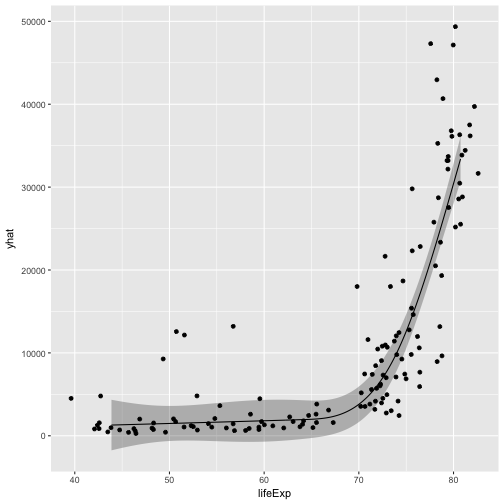
ggplot( data = predvals, aes(x = pointest, y = adjvalue)) + ## Use inherited data; ## specify aesthetics geom_ribbon( aes(ymin = lcl, ymax = ucl) ) + ## Use inherited data + aesthetics geom_line() + ## Add raw data geom_point( aes(x = covar, y = orgvalue), data = orgdata )⚖️ Scales for Details ⚖️
aesthetics
What data is mapped to which plot characteristic
aes(x = ...)
scales
How to map
data to plot characteristics
scale_x_...(...)
Boxplot Example
aes(thetics)
Put gdpPercap on Y axis
ggplot( data = gap2007, aes(x = continent, y = gdpPercap)) + geom_boxplot() + geom_point() + scale_y_continuous( limits = c(0, 5000), breaks = seq(0, 5000, 1025), labels = scales::comma, name = "GDP per Capita" )scales
- Set the axis limits
- "Break" axis at these places
- "Name" the axis "GDP Per Capita"
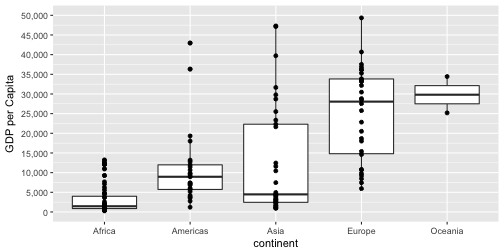
Note: ggplot2 automatically set gridlines at our break points!
Barchart Example
Note how scales control the legend!
aes(thetics)
"Fill" the bars with colors by sex
ggplot( data = rct_df, aes(x = trt, y = npts, group = sex, fill = sex)) + geom_bar( stat = "identity", position = "dodge2" ) + scale_fill_hue( h = c(90, 270), l = 40, ## change *hues*, *lightness* name = "Patient Sex" ## change *name* )scales
- Use a different color palette
- Change name to "Patient sex"
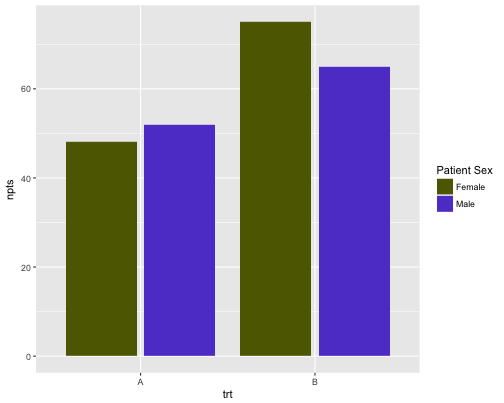
Types of scales
Scales generally correspond to aesthetics. Some common scale types:
scale_[x, y]_[continuous/discrete]scale_[colour, fill]_[many options!]scale_size_...,scale_shape_...,scale_alpha_...
This is not an exhaustive list. See the ggplot2 reference pages for more options.
Note: For color scales and aesthetics, you can use either color or colour.
Types of scales
Scales generally correspond to aesthetics. Some common scale types:
scale_[x, y]_[continuous/discrete]scale_[colour, fill]_[many options!]scale_size_...,scale_shape_...,scale_alpha_...
This is not an exhaustive list. See the ggplot2 reference pages for more options.
Note: For color scales and aesthetics, you can use either color or colour.
scales have intelligent default values, but you can use different scale types to use specific values you choose. Examples:
- A particular color palette
- Beginning and ending sizes (maybe you want the smallest size to still be seen on a projector)
- Breaks on X, Y axes at clinically relevant points
Your Turn!
Using the boxplot we made earlier, use scales (and maybe aesthetics) to
- Change the name of the X axis
- Make each country's raw data a different color
- Not include a legend
?scale_x_discrete
?scale_color_hue
Your Turn!
Using the boxplot we made earlier, use scales (and maybe aesthetics) to
- Change the name of the X axis
- Make each country's raw data a different color
- Not include a legend
?scale_x_discrete
?scale_color_hue
ggplot( data = gap2007, aes(x = continent, y = gdpPercap)) + geom_boxplot(outlier.shape = NA) + geom_point( aes(color = continent), position = position_jitter(width = 0.2), alpha = 0.6 ) + scale_x_discrete(name="Continent") + scale_color_hue(guide = FALSE)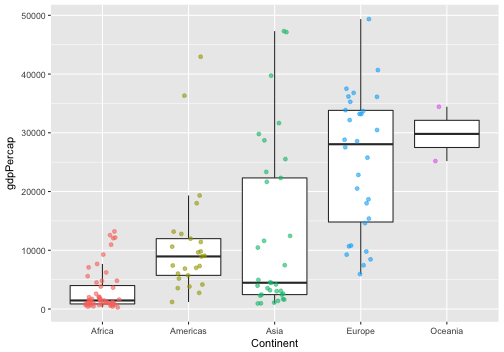
Choosing a color scale
By default, ggplot2 uses color scales that allow for the most difference between categories on a color wheel, or to show a spectrum of continuous values.
You can change these defaults in several ways, including:
- Tweak the defaults with
scale_color_hue()orscale_color_gradient()- for example, change the gradient color from the default blue to green, or change the range of hues for a categorical variable - Use one of the built-in ColorBrewer schemes, which are built to handle sequential, diverging, and qualitative color schemes (
scale_color_brewer()for categorical,scale_color_distiller()for continuous) - Supply a manual color scheme, using words like
"blue"or hex colors (eg,#FAFAFA):scale_color_manual() - I personally like the
viridiscolor schemes. (These are not currently included inggplot2itself, but will be in the next version released to CRAN this summer. You can install theviridisLitepackage to use them now.) These scales print well, even in black & white, and are built to be perceived by people with color blindness.
(All scale options above also apply to scale_fill_xxxx)
Color Scale Examples: Default Hues
p <- ggplot(data = gap2007, aes(x = gdpPercap, y = lifeExp)) + geom_point(aes(color = country, size = pop), alpha = 0.5)p + scale_color_hue(guide = FALSE)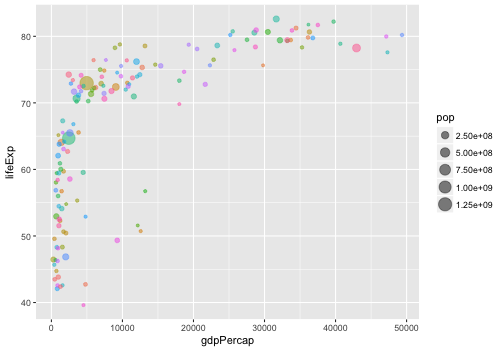
Color Scale Examples: Manual Values
p + scale_color_manual(values = country_colors, guide = FALSE)
Color Scale Examples: viridis
library(viridisLite) ## or install development version of ## ggplot2 from Githubp + scale_color_viridis_d(guide = FALSE)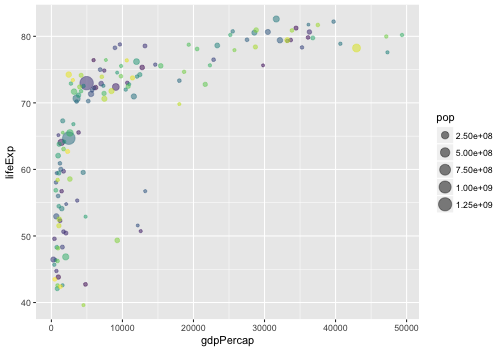
🔠 Same Concept, Many facets 🔢
We can use facets to show the same visualization for related groups.
Example: GDP vs Life Expectancy
ggplot(data = gap2007, aes(x = gdpPercap, y = lifeExp)) + facet_wrap(~ continent) + geom_point() + geom_smooth()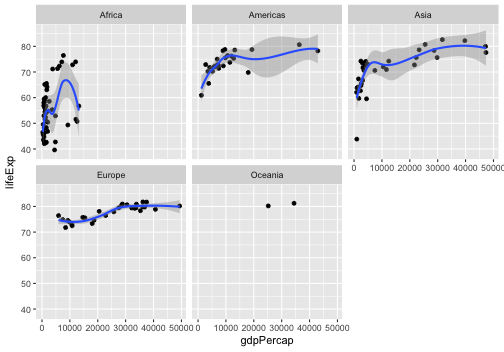
facet_wrap()
You have one categorical variable
facet_grid()
You have two categorical variables, want to show each combination
Both have these arguments (among others):
nrow,ncol: if you want a specific layoutscalesfixed: default; same for every panelfree_y,free_x,free: allow X and/or Y axis to change for each panel
facet_grid() example
First + last years available for each continent in the gapminder data
ggplot( data = subset( gapminder, year %in% c(1952, 2007) & !(continent == "Oceania") ), aes(x = gdpPercap, y = lifeExp)) + facet_grid(year ~ continent) + geom_point() + geom_smooth()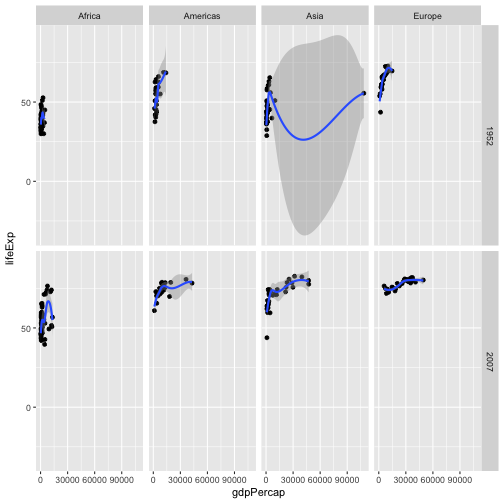
facet_grid() example
First + last years available for each continent in the gapminder data
ggplot( data = subset( gapminder, year %in% c(1952, 2007) & !(continent == "Oceania") ), aes(x = gdpPercap, y = lifeExp)) + facet_grid(year ~ continent) + geom_point() + geom_smooth()
Leaving scales consistent between panels is great for comparisons between panels (like here). If we are more interested in informing than comparison, we may want to let the scales vary by panel.
facet_grid() example
ggplot( data = subset( gapminder, year %in% c(1952, 2007) & !(continent == "Oceania") ), aes(x = gdpPercap, y = lifeExp)) + facet_grid( year ~ continent, scales = "free_x" ) + geom_point() + geom_smooth()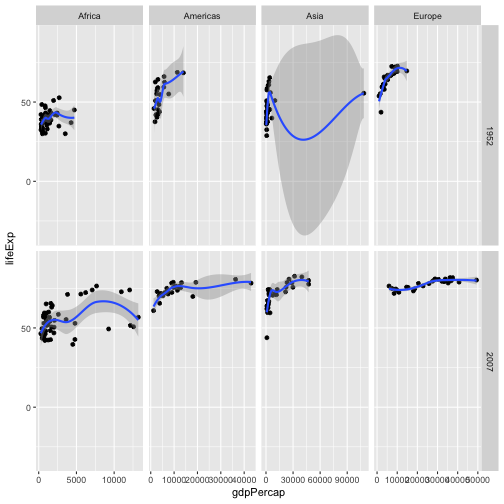
facet_grid() example
ggplot( data = subset( gapminder, year %in% c(1952, 2007) & !(continent == "Oceania") ), aes(x = gdpPercap, y = lifeExp)) + facet_grid( year ~ continent, scales = "free_x" ) + geom_point() + geom_smooth()
The X axis scales for each column are still the same for the two rows, allowing us to see the differences between 1952 and 2007 clearly for each continent.
But the X axis scales are different from column to column; we can see the relationships for Africa without being affected by the larger GDPs found in Europe, for example.
Your Turn!
Using the original gapminder data for 1952 and 2007, update your boxplots of GDP by continent to show one column for each of those two years, and one row for each continent.
Hint: You can set the X aesthetic to always be 1.
Your Turn!
Using the original gapminder data for 1952 and 2007, update your boxplots of GDP by continent to show one column for each of those two years, and one row for each continent.
Hint: You can set the X aesthetic to always be 1.
ggplot( data = subset( gapminder, year %in% c(1952, 2007) ), aes( x = 1, y = gdpPercap )) + facet_grid( continent ~ year, scales = "free_y" ) + geom_boxplot() + geom_point()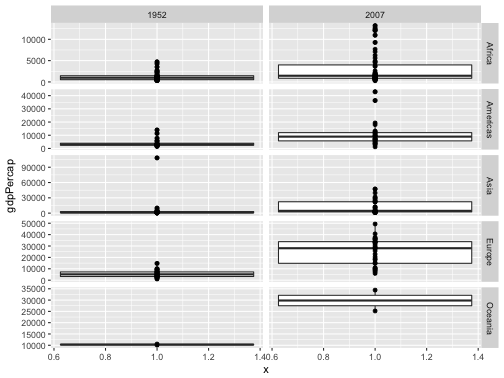
🌺 Themes 🌺
Give your plots a different look
Control plot elements not related to data
Change the look of your plot
Using ggplot2 themes, it is easy to give your plots a different look with one line.
p <- ggplot(data = gap2007, aes(x = gdpPercap, y = lifeExp)) + geom_point()p + theme_bw()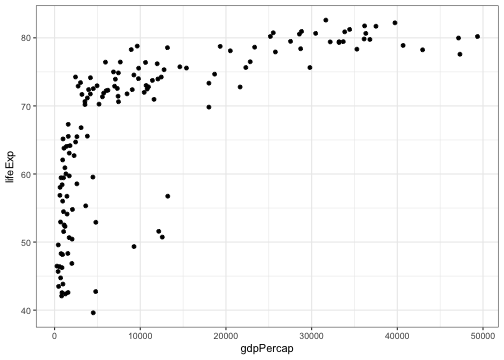
p + theme_minimal()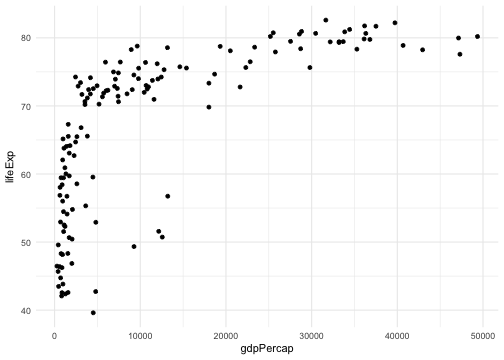
Changing Plot Elements with themes
We also use themes to change elements of the plot that are not related to data:
- Increase font sizes
- Change colors or font faces
- Change plot backgrounds, gridlines
p + theme_minimal()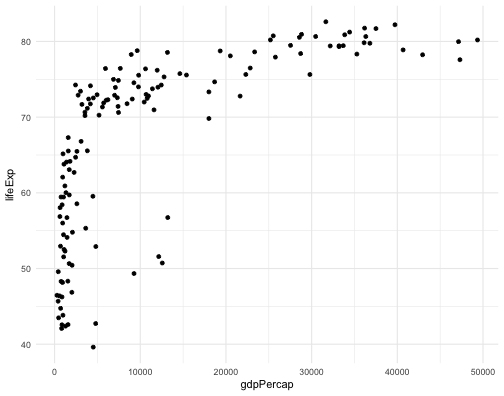
p + theme_minimal() + theme( panel.border = element_rect( fill = NA, color = "#b756b9", size = 5 ) )
elements
Pieces of the theme are controlled by the element functions (examples):
element_line(): gridlines, axis lineselement_text(): axis labels, titles, captionselement_rect(): plot and panel backgrounds,facetstrip backgroundselement_blank(): can be used for any element to "make it disappear"
Use these functions to set aspects like sizes, colors, font faces...
Your Turn!
Give a boxplot we made earlier a different overall theme, then customize at least one element. You might...
- Make the axis text bold or bigger
- Make the gridlines thicker or disappear
- Make the
strip.backgrounda different color
Your Turn!
Give a boxplot we made earlier a different overall theme, then customize at least one element. You might...
- Make the axis text bold or bigger
- Make the gridlines thicker or disappear
- Make the
strip.backgrounda different color
p + theme_minimal() + theme( axis.title.x = element_blank(), axis.text.x = element_blank(), strip.background = element_rect(fill = "gray90"), panel.background = element_rect(fill = NA, color = "gray90"), legend.position = "none" )
Adding Labels and Titles
We may want to add a title to our plot, or a caption to give additional information about how something was defined. Maybe we want to name an aesthetic "Patient Sex" instead of "sex" but with less typing than scale_x_discrete(name = "Patient Sex").
labs() allows us to set these elements:
titlesubtitlecaption- titles for
aesthetics(these will show up in the legend, or X/Y axis titles)
p + labs(x = "My X axis title")Adding Labels and Titles
We may want to add a title to our plot, or a caption to give additional information about how something was defined. Maybe we want to name an aesthetic "Patient Sex" instead of "sex" but with less typing than scale_x_discrete(name = "Patient Sex").
labs() allows us to set these elements:
titlesubtitlecaption- titles for
aesthetics(these will show up in the legend, or X/Y axis titles)
p + labs(x = "My X axis title")Your Turn!
Use labs() to add a plot title and change the Y axis title on the plot you just made.
Controlling Non-Data Elements
To control elements of the plot that represent data, but not in a way directly tied to our data, we can still use aesthetic qualities. However, we will set them outside the aes(...) function.
Example: We want all our points to be a certain color, or to make a line width thicker to be seen better in a presentation.
ggplot( data = gap2007, aes(x = gdpPercap, y = lifeExp)) + geom_point( color = "#a7a9ac", alpha = 0.75, size = 1.25 ) + geom_smooth( fill = "#532354", color = "#b756b9", alpha = 0.2, size = 2 ) + geom_rug( alpha = 0.3, color = "#532354" )
🌎 Full Examples with gapminder 🌏
Goal
Create a publication-quality chart showing the relationship between gross domestic product and life expectancy, 1952 and 2007.
Preparation
1) Create a subset of the data
## Only look at 1952, 2007gap_sub <- subset( gapminder, year %in% c(1952, 2007))2) Initialize our plot object
gdp_exp <- ggplot( data = gap_sub, aes(x = gdpPercap, y = lifeExp))gdp_exp
facet by year and continent
gdp_exp <- gdp_exp + facet_grid(year ~ continent)
Add data points
We want to use a different color for each country, and make our point sizes vary according to the countries' population size.
gdp_exp <- gdp_exp + geom_point( aes(color = country, size = pop), alpha = 0.6 ## to help overplotting )Add data points
We want to use a different color for each country, and make our point sizes vary according to the countries' population size.
gdp_exp <- gdp_exp + geom_point( aes(color = country, size = pop), alpha = 0.6 ## to help overplotting )
😱 Fix it! With scales
As we saw, a legend for color will not be helpful; there are too many countries.
However, a legend would be helpful for the population sizes.
We will use two scales to
1) Specify the colors we want, using scale_color_manual and country_colors, a named vector of hex colors that comes with the gapminder package
head(country_colors)## Nigeria Egypt Ethiopia Congo, Dem. Rep. ## "#7F3B08" "#833D07" "#873F07" "#8B4107" ## South Africa Sudan ## "#8F4407" "#934607"2) Format a legend for our population sizes
Modification of scales
gdp_exp <- gdp_exp + scale_color_manual( ## Manually specify colors values = country_colors, ## Turn off the legend for colors guide = FALSE ) + scale_size( range = c(3, 7), labels = function(x){ scales::comma(x / 1000000) }, name = "Population\n(x 1M)" )
Exploratory data analysis
We see that there is a lot of space on the X axis that may be unnecessary, possibly caused by one point. What point is it?
ggplot( data = gap_sub, aes(x = gdpPercap)) + geom_histogram()
Exploratory data analysis
We see that there is a lot of space on the X axis that may be unnecessary, possibly caused by one point. What point is it?
ggplot( data = gap_sub, aes(x = gdpPercap)) + geom_histogram()
The extreme outlier in 1952 is from Kuwait; looking at other years in the gapminder data, it seems to be a legitimate value, but including it is keeping us from seeing the other data as clearly.
We'll exclude it from our plot, but will make a note in a figure caption.
Modify X axis scale
## Save X axis title to a string so we can see the whole thingxtitle <- "Gross Domestic Product per Capita\n(x $1,000 USD)"gdp_exp <- gdp_exp + scale_x_continuous( limits = c(0, 55000), labels = function(x){ scales::dollar(x / 1000) }, name = xtitle )
Add Labels
plottitle <- "GDP vs Life Expectancy, 1952 and 2007"captitle <- sprintf( "Kuwait's 1952 values were excluded due to its extremely high GDP of $%s.\nAverage life expectancy at that time was %s.", format( round(subset(gap_sub, year == 1952 & country == "Kuwait")$gdpPercap), big.mark = "," ), round(subset(gap_sub, year == 1952 & country == "Kuwait")$lifeExp, 1))gdp_exp <- gdp_exp + labs( title = plottitle, subtitle = "Source: gapminder.org/data", caption = captitle, y = "Life Expectancy (Years)" )
Modify Theme Elements
We want to
- Add space between the X axis and title
- Add space between X axis title and caption
- Italicize the caption
- Bold plot titles, axis titles, and strip text
- Move the legend to the bottom
gdp_exp <- gdp_exp + theme_bw() + theme( plot.title = element_text( face = "bold", size = 16 ), axis.title.x = element_text( vjust = 0 ), plot.caption = element_text( vjust = 0, face = "italic" ), strip.text = element_text( face = "bold", size = 12 ), legend.position = "bottom", legend.direction = "horizontal" )Final Result

Your Turn!
Using any of these strategies (or others!), make changes to the boxplots we've been working with.
Some ideas:
- Changing the color of the boxplots, or removing the inside altogether
- Changing the breaks of the Y axis
- Adding axis, plot titles
- Citing the source of our data
Any other ideas are welcome!
Saving Your Plots
The ggsave function allows us to easily save our figures in several formats. For example, you might want to create a PDF of the figure for a journal submission, but have a PNG for PowerPoint presentations.
ggsave( filename = "gapminder_gdplifeexp.pdf", gdp_exp, device = "pdf", path = "figures/", width = 10, height = 7, units = "in")ggsave( filename = "gapminder_gdplifeexp.png", gdp_exp, device = "png", path = "figures/", width = 10, height = 7, units = "in")Saving Your Plots
The ggsave function allows us to easily save our figures in several formats. For example, you might want to create a PDF of the figure for a journal submission, but have a PNG for PowerPoint presentations.
ggsave( filename = "gapminder_gdplifeexp.pdf", gdp_exp, device = "pdf", path = "figures/", width = 10, height = 7, units = "in")ggsave( filename = "gapminder_gdplifeexp.png", gdp_exp, device = "png", path = "figures/", width = 10, height = 7, units = "in")Your Turn!
Save the results of your plot to a figures/ directory in two different formats.
Helpful Resources
ggplot2reference page- Cookbook for R
- Data visualization and graphics for communication, R for Data Science
ggplot2extensions, forgeomsthat are not included inggplot2itselfggthemrfor building custom themes and color palettes (not currently on CRAN; install from Github)- Color palettes:
- ColorBrewer
- colorhexa.com
- Theoretical basis: